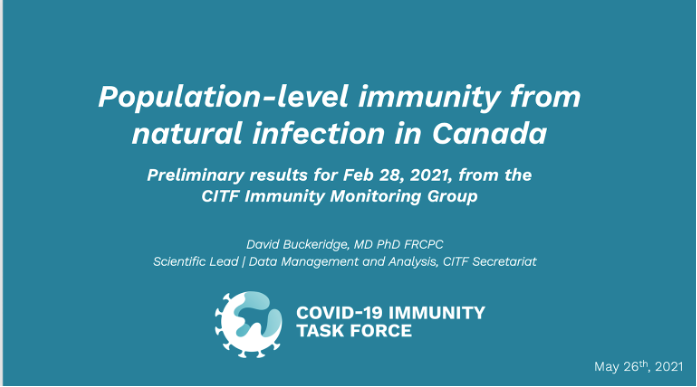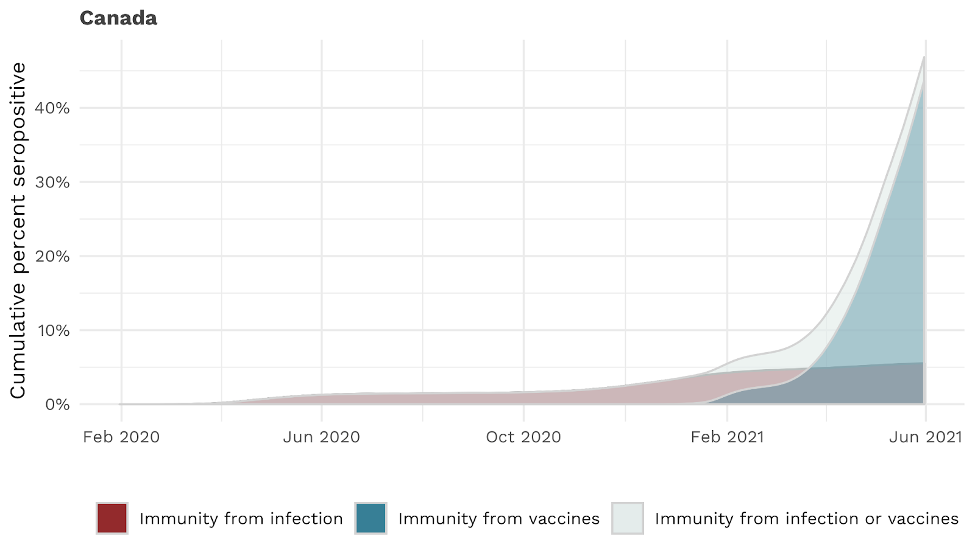A Case Study in
Infectious Disease Epidemiology
The COVID-19 pandemic has had vast impacts in Canada and globally, and understanding levels of immunity to the virus is critical to curbing spread of the disease.
Precision Analytics worked closely with the COVID-19 Immunity Task Force (CITF) to build and implement complex statistical models that leverage various sources of publicly-available data, as part of the effort to estimate population-levels of immunity to SARS-CoV-2 in Canada. These models were also applied to the global context to support the CITF’s collaboration with the World Health Organization (WHO) , with the goal of estimating country-level immunity worldwide.
The CITF was formed by the Government of Canada in April 2020, during the first wave of the COVID-19 pandemic, to better understand COVID-19 immunity in Canada. The Task Force is made up of expert clinicians and scientists in diverse fields, from immunology to mathematics, who are focused on understanding the nature of immunity arising from the novel coronavirus that causes COVID-19.
To that end, the CITF is supporting numerous studies to determine the extent of SARS-CoV-2 infection in Canada (in the general population as well as in specific communities and priority populations ), understand the nature of immunity following infection, develop improved antibody testing methods, and help monitor the effectiveness and safety of vaccines as they are rolled out across Canada. The Task Force and its Secretariat work closely with a range of partners, including governments, public health agencies, institutions, health organizations, research teams, other task forces, and engages communities and stakeholders.
The Task Force’s overall objective is to generate data and ideas that inform interventions aimed at slowing—and ultimately stopping—the spread of SARS-CoV-2 in Canada. Their objectives in relation to infection and immunity are to answer practical questions, such as:
- How many Canadians have been infected with SARS-CoV-2 to date?
- What is the distribution of these infections across geographic areas, age groups, and priority groups (e.g., residents of long-term care facilities)?
- How well does seroprevalence (presence of antibodies in a blood sample) correlate with immunity to COVID-19?
- How long does immunity from infection last? How long does immunity from vaccination last?
- How many Canadians are immune to COVID-19 at this point?
The CITF is comprised of world-class researchers and clinicians who volunteer their time to improve the Canadian public health response to COVID-19 via participation in the Task Force. They needed an agile team with expertise in epidemiology, applied biostatistics and statistical computing to collaboratively design and implement statistical models to estimate population-level immunity.
Our team at Precision Analytics was excited to engage in a collaboration that would harness our expertise and have a direct impact on public and global health.
Among the CITF’s numerous partnerships are two with blood donation organizations that date back to early in the pandemic. The CITF partnered with Canadian Blood Services and Héma-Québec to test samples of blood dating back to the beginning of the outbreak in 2020 and to measure the prevalence of antibodies over time. These “seroprevalence surveys” are among those that provide important insights into infection-acquired and vaccine-induced immunity in different regions over time.
SeroTracker is the first and only monitoring platform for aggregating and disseminating data from international seroprevalence studies, and they are supported by the CITF.
The CITF supports other seroprevalence studies on general and targeted populations, some of them co-funded with the Canadian Institutes of Health Research (CIHR) . These include studies focusing on children, healthcare workers, correctional facility populations, community populations and others. The CITF also supports several immune science studies and studies investigating how to optimize immunologic testing , as well as many vaccine surveillance studies .
At-home antibody tests via dried blood spots were validated through a collaboration between the CITF and the National Microbiology Laboratory , and many CITF-supported studies, including a major national Statistics Canada study , were able to collect samples from thousands of Canadians in all parts of the country thanks to these at-home antibody testing kits.
Other sources of data include:
- Province-specific and national-level epidemiological reports
- Data collated and maintained by the COVID-19 Canada Open Data Working Group
In order to estimate population-level immunity, the CITF needed to combine various data sources into one statistical framework. The challenge of estimating population-level immunity is threefold:
- There is no one perfect data source, as each one is subject to some amount of sampling error and/or biases or has other limitations. For example, seroprevalence surveys are done irregularly over time and blood donors may not be a representative sample of the general population.
- There is no gold standard or ground truth to benchmark against; true immunity levels are and always will be unknown, meaning estimates are triangulated rather than explicitly validated.
- Models need to be updated regularly as new data are produced, and tailored as advances in the understanding of SARS-CoV-2 immunity arise; for example, as time passes during the pandemic, concerns of waning immunity hold a larger weight.
In the early stages, the priority was to find an adequate Phase 1 modelling approach, so that the CITF could begin sharing regular updates on population immunity as per their mandate . Their experts proposed an approach that used a weekly time series of COVID-19 deaths, infection fatality ratios (IFRs) , and irregular seroprevalence surveys to estimate the true total number of infections - and from that the existing immunity.
In this initial phase, vaccination rollout in Canada had just begun, so these results were solely based on naturally occurring immunity via infection. The model was later adjusted to account for vaccination, as rates drastically increased in the Spring of 2021 and immunity was largely acquired via immunization. Our team continued to collaborate closely with their experts to design and implement a more sophisticated model that relied on confirmed COVID-19 cases rather than death counts, as the latter suffers from sparsity once data are stratified by region or age group.
At each stage, a Bayesian modelling framework was used and models were implemented in Stan . The benefit of this approach is that we could easily implement hierarchical models to reflect the structure of the data, and we could encode information via the priors ; for example, the infection fatality ratio (IFR), while unknown, has likely ranges based on studies from other countries. This approach allowed us to integrate data from as many sources as possible to provide the best estimates.

Fig 1. Initial results were shared in a joint webinar on May 26, 2021.
Within weeks of beginning our collaboration, we were able to produce preliminary results for the CITF to disseminate in their first report on infection-acquired immunity across Canada. The initial results were shared in a joint webinar on May 26, 2021 between Héma Quebec, Canadian Blood Services, and the CITF.
Given the quickly rising rates of vaccination across Canada, subsequent modelling included immunity from immunization as well as infection-acquired immunity.

Fig 2. Preliminary estimates for the cumulative percentage of Canadian population who were seropositive as a result of infection (red), vaccination (dark blue), or either infection or vaccination (light blue) from February 2020 through June 2021.
The collaboration between the CITF and Precision Analytics is ongoing and future work will include regular monthly reports of Canadian and global estimates as the pandemic evolves. We deeply appreciate the opportunity to contribute to Canada’s efforts to battle the pandemic, nationally and worldwide, through the scientific and clinical research supported by the COVID-19 Immunity Task Force.
Our team has worked extensively on projects related to the COVID-19 pandemic. We have the agility to deliver results rapidly and domain knowledge in applied statistics and clinical epidemiology. Please get in touch to learn more.

Let’s get work together
Contact us to reduce your data analysis workload and optimize your workflow.
Contact Us
